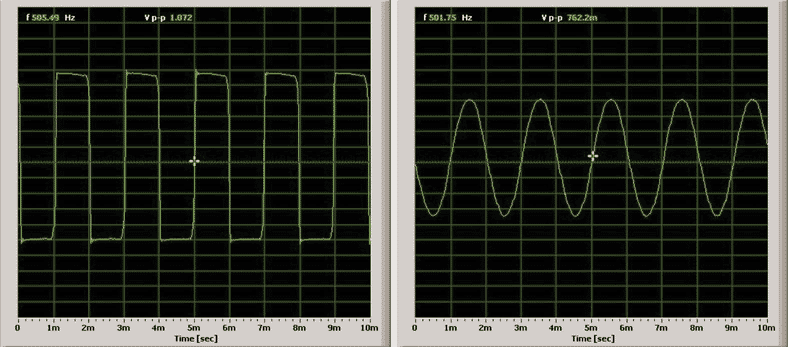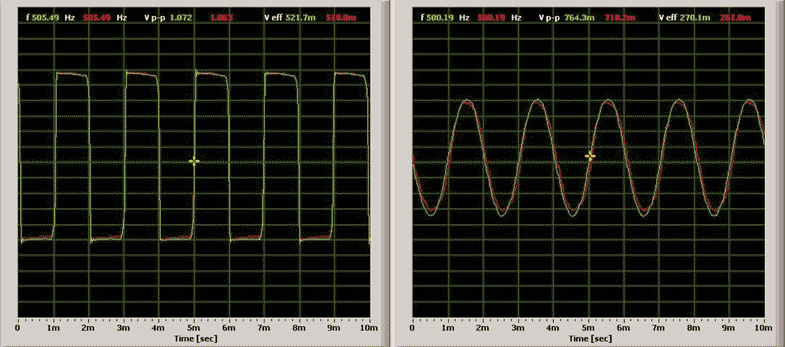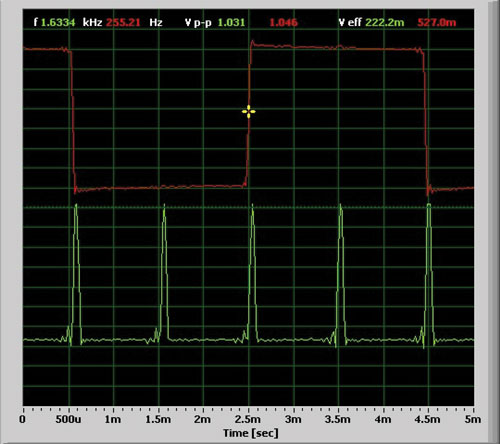Part 1 - Front End, Sampling Clock Generator
Examples of Active Reconstruction Filters
Figure 7 and Figure 8 show active filter designs that should work well in place of a simple passive RC filter. Figure 7 shows a second-order Sallen-Key filter, with a corner frequency of about 39 kHz, using standard resistance and capacitance values. The AD8042 and AD822 dual op amps, specified for low supply voltage and wide swing, are good choices. The filter has a gain of +1 in the pass band.
 |
|
| Figure 7. | Sallen-Key 39-kHz low-pass filter. |
Figure 8 shows another second-order multiple-feedback (MFB) filter with a corner frequency of about 33 kHz, using standard resistance and capacitance values. This filter has a pass-band gain of –1, so – if it is used – select the invert button on the scope software in order for the displayed waveform to be right-side up.
 |
|
| Figure 8. | MFB 33-kHz low-pass filter. |
Powering the Circuits
The AD783 and the amplifier used in the reconstruction filter require dual power supplies. These could be provided simply by six AA batteries, with three providing +4.5 V and the other three providing –4.5 V. Or, a single 9-V battery could be used, with a resistance divider providing a midsupply voltage as the ground – which would need to be buffered by an op amp to supply any ground currents required by the circuit; alternatively, an adjustable linear regulator could be used to produce a voltage of approximately 4.5 V with respect to the negative battery terminal for use as the ground reference.
Yet another option would be to use the +5 V provided by a spare PC or laptop USB port. The –5 V could be generated by a dc-to-dc voltage inverter, such as the Analog Devices ADM8829 – in a surface-mount package – or the ICL7660 in a DIP from Intersil. Special care will be required to avoid interference from switching noise generated by the dc-to-dc voltage inverter.
Input Attenuators
The small-signal gain of the AD783 is much higher than its full swing bandwidth. By inserting a 10:1 resistive attenuator ahead of the sampler to limit the maximum signal swing, usable bandwidth well beyond 20 MHz is possible. Relatively low cost scope probes are available from companies such as Syscomp Electronic Design, Ltd.2 (Figure 9).
 |
|
| Figure 9. | P6040 1×/10× scope probes. |
At this writing:
- Oscilloscope probes (P6040) with 40-MHz bandwidth, 1×/10×switchable, cost $29.99 per pair from Syscomp Electronic Design.
- HobbyLab3 sells the 20-MHz 10:1 version oscilloscope probes (GT-P6020) for $19.50 per pair.
- Gabotronics.com4 sells both 100-MHz P2100 and 60-MHz P2060 generic probes for about $10.00 each.
Using the Probes
The P2100 100-MHz 10× probes, used to take the Soundcard2 screen shots in Figure 10, Figure 11, and Figure 12, can compensate for input capacitance in the range from 10 pF to 35 pF. This seems to be a sufficient adjustment range for the proposed circuit if the PC board wire lengths are kept as short as possible. With the 10× probe, the input looks like 10 MΩ and 18 pF and can support input voltages up to ±30 V.
To demonstrate the AD783 sample-and-hold input stage, the probe compensation was first adjusted using a 1-kHz flat-top square wave. The screen shots show the response for various signals with frequencies of 1 MHz and 50 MHz. The two screen shots in Figure 10 show one channel with a 1 MHz, 5-V p-p square wave (a), and a 50-MHz, 5-V p-p square wave (b). In each case, the sample clock was adjusted for a downsampled signal frequency of about 500 Hz, so that any sound-card response differences were eliminated. Thus, the effective time scale is 500 ns/division for the screen shot on the left and 10 ns/division for the screen shot on the right. The sound card input gain was set for the scope software to report a 1.072-V p-p amplitude for the 1-MHz input and a 762.2-mV p-p amplitude for the 50-MHz input. The ratio of 0.7622/1.072 is close to –3 dB. This measurement shows that the combination of the 100-MHz 10× probe and the AD783 has a 50-MHz, 3-dB bandwidth.
 |
|||
| a) | b) | ||
| Figure 10. | Single channel 10× probe 1 MHz (a) and 50 MHz (b) 5-V p-p input square waves. | ||
In Figure 11, the same 1-MHz (a) and 50-MHz signals (b) are applied to both channels. From these two overlaid screen shots of both channels, one can see that there is good gain-, offset-, and delay-matching between the two channels.
 |
|||
| a) | b) | ||
| Figure 11. | Dual-trace 2-channel matching, 10× probes, 1-MHz (a) and 50-MHz (b) 5-V p-p input square waves. | ||
The final screen shot (Figure 12) is of a 375-kHz, 5-V p-p square wave (red trace) and a 1.5-MHz 42 ns wide 5-V p-p pulse (green trace). The horizontal scale is 333 ns/division. The AD783 sampler maintains the full 5-V swing, even for these narrow 42-ns wide pulses.
 |
|
| Figure 12. | Dual-trace 2-channel, 10× probes, 375-kHz, 5-V p-p square wave and 1.5-MHz, 42-ns 5-V p-p pulse. |
References
- Visual Analyser is a complete professional real-time software package that transforms a PC into a complete set of measurement instruments. No new hardware is necessary as it uses the PC’s sound card. http://www.sillanumsoft.org/.
- Syscomp Electronic Design, Ltd. http://www.syscompdesign.com/Accessories.html.
- HobbyLab http://securedwithssl.com/HobbyLab-us/product/63258ffa-dcc8-4508-8152-d2461d943169.aspx.
- Gabotronics http://www.gabotronics.com/accesories-and-cables/view-all-products.htm.
- The PC-based Soundcard oscilloscope receives its data from the sound card with 44.1-kHz sampling rate and 16-bit resolution. Also available is WaveIO, a Soundcard Interface for LabView software. http://www.zeitnitz.de/Christian/scope_en.